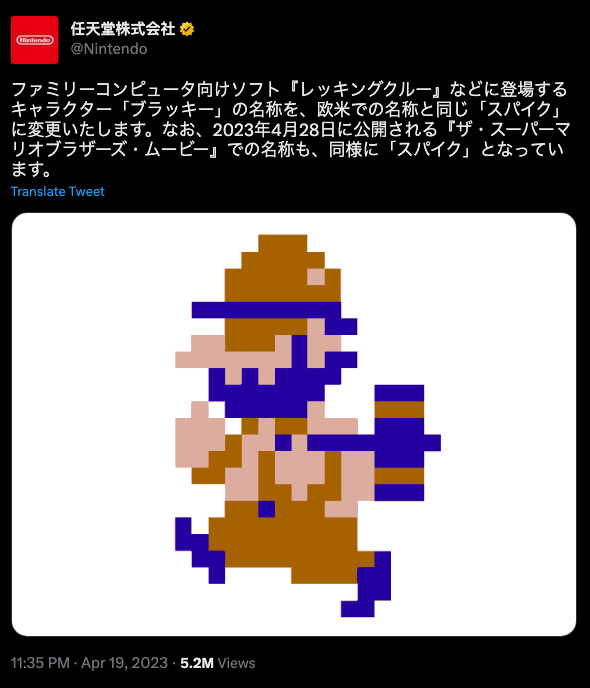Why Did Nintendo Change Foreman Spike’s Name?
Consider this an ever-so-brief follow-up to the previous post on Foreman Spike. And yes, I’m as surprised as anyone that he’s getting more than one post — on here or anywhere, really. But on April 19, Nintendo’s official Japanese Twitter announced that henceforth, the character would be known in Japan as Spike and not as his previous name, ブラッキー (Burakkī, “Blackie”).
This is interesting for a few reasons, the first one being that we don’t know why Nintendo has chosen to do this; no reasoning is provided as to why they made this change. As an American gamer, however, I’m inclined to think that this represents Nintendo’s effort to be more racially sensitive or at least to step ahead of a potential controversy. That original name does sound a hell of a lot like a racial epithet, even if Spike himself looks to be the same race as Mario and Luigi. As I said in the previous post, that name is probably as much a nod to Spike’s status as a Bluto-inspired character as it is a reference to the color of his beard.
I’d imagine the change is also a result of Nintendo’s desire to standardize the brand internationally. After all, this is the video game series where the most prominent female character was known as Princess Toadstool (or thereabouts) in many non-Japanese-speaking territories until Super Mario 64, when she took on the name she’d always had in Japan, Peach. But then again, Bowser still has a name internationally that he doesn’t have in Japan, and he’s a much more important character to the series than Spike is. Maybe the more fitting analogy is Pauline becoming the name of the damsel-in-distress in all versions of the Donkey Kong games starting with the 1994 Game Boy edition, after having been called Lady in the original Japanese-language versions, although in that case Lady is considered a separate character from Pauline. (And yes, a post on the history of Pauline is forthcoming.)
Nintendo changing Spike’s Japanese name could also mean that The Super Mario Bros. Movie is foundational to Nintendo’s long-term goals for the games. In fact, that is probably a given, considering how the movie has raked in more than a billion dollars globally as of this past weekend. I don’t think this means that Jack Black will take over voicing Bowser in the games, exactly, but I do think we could see the movie version of these characters in some kind of future tie-in title. If Nintendo does something like that, it’s possible that Spike could be part of it. Even if the movie versions of these characters stay out of video games, however, a lot of people have now seen the movie and would therefore potentially expect to see a version of Spike in a future video game. In this sense, the name change is probably the first example we have of The Super Mario Bros. Movie impacting the games that inspired it.
Additionally, it’s worth pointing out that the name Nintendo of Japan reintroduced this character with is スパイク or Supaiku, and not Foreman Spike, which is how he’s usually referred to in English-language discussions. It was pointed out to me, in a Discord exchange and then again in comment on my previous Spike post, that that name Foreman Spike is kind of a misnomer and most likely a misinterpretation of the instruction manual.
(Via.)
Looking at the manual now, it’s pretty clear that foreman was not meant to be part of his name so much as a description of who Spike is. Nonetheless, the association stuck, and he’s been called Foreman Spike so far pretty much everywhere but the new Mario movie and this tweet about his name change. It remains to be seen if this will remain part of the character, either out of habit or because it’s a handy way to differentiate the character from the generic enemy character also called Spike.
The Japanese version of the manual, laid out slightly differently, identifies Spike not as a foreman but as 意地悪おじさん, with 意地悪 (ijiwaru) meaning “mean” and おじさん (ojisan) meaning “old man”. The text above Spike, 要注意人物 , translates as something like “someone to be wary of.” Again, not a title but a description of him, with the added bonus of ijiwaru being a word that Waluigi’s name is playing off, therefore underscoring the connection has to Wario.
(Via.)
Finally, in posting its version of this news story, Kotaku linked not to the new Spike post on this blog but somehow found a post from 2008 on my old, discontinued blog, Back of the Cereal Box. There, I posted the theory that his original, Japanese name ラッキー (Burakkī) could be interpreted as “Breaky,” given the game’s demolition theme, but I’ve since learned that this is not the case; that’s not a valid interpretation of the Japanese characters, and I didn’t include it in the previous post for that reason. I’d say it’s wild to consider how my post about this character from more than a decade ago still pops up in discussion of him today, but then again the composite art I made of Spike for this 2010 post about obscure Mario characters still gets copied and pasted into articles today.
Maybe writing about video games online leaves you some kind of legacy after all? Either way, nice to know I haven’t moved on from the same stuff I was into years ago.





